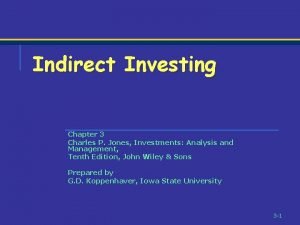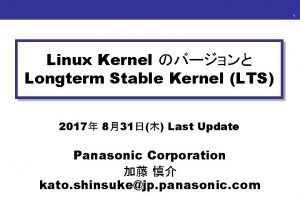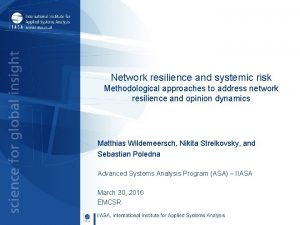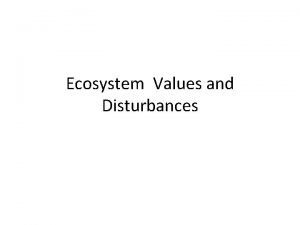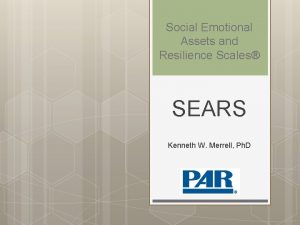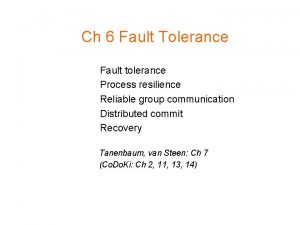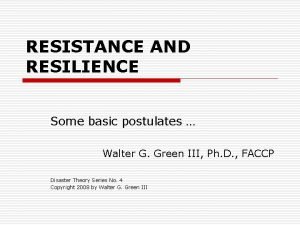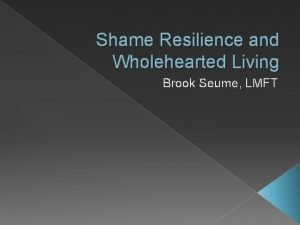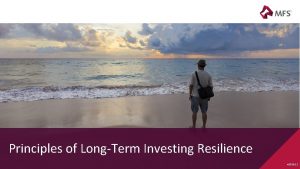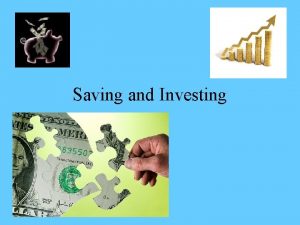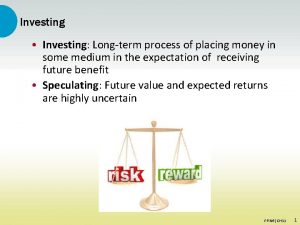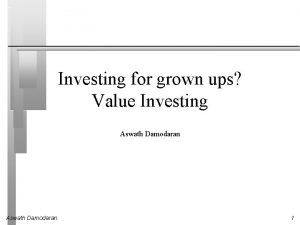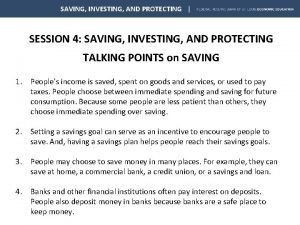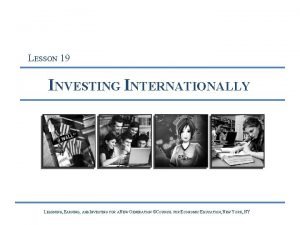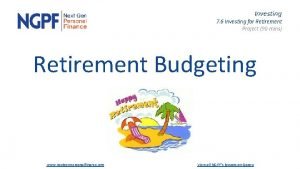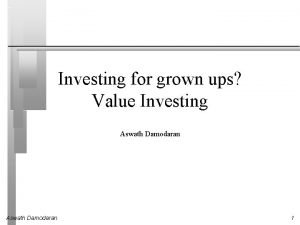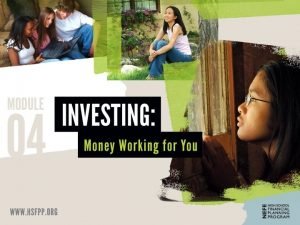10 Principles of LongTerm Investing Resilience 43029 7

![Building Resilience for the Long Term [Presenter Name] [Title] MFS Fund Distributors, Inc. may Building Resilience for the Long Term [Presenter Name] [Title] MFS Fund Distributors, Inc. may](https://slidetodoc.com/presentation_image_h/7ec10406a8605595df7f29d573f8cb18/image-2.jpg)

































- Slides: 35

10 Principles of Long-Term Investing Resilience 43029. 7
![Building Resilience for the Long Term Presenter Name Title MFS Fund Distributors Inc may Building Resilience for the Long Term [Presenter Name] [Title] MFS Fund Distributors, Inc. may](https://slidetodoc.com/presentation_image_h/7ec10406a8605595df7f29d573f8cb18/image-2.jpg)
Building Resilience for the Long Term [Presenter Name] [Title] MFS Fund Distributors, Inc. may have sponsored this seminar by paying for all or a portion of the associated costs. Such sponsorship may create a conflict of interest to the extent that the broker-dealer's financial advisor considers the sponsorship when rendering advice to customers. MFS Fund Distributors, Inc. , Boston, MA 43029. 7 MFSP-INVWRES-PRES-3 -20

Negative Market Headlines Can Create Panic Anxiety about investing may start to creep in downturn currencies coronavirus pandemic Pension funds dry up Economic disaster looming global trends risk credit crunch Interest rates slump Endorses stimulus package Fear grows Profits down Confidence wobbles mortgage spending power financial crisis Market jitters Stocks tumble assets dollar weakens bust emergency loans Monetary policy inflation Anxiety deepens Announces trading loss Shares worthless crash capital investment recession forecast 43029. 7 3

More Information, Faster = More Noise and More Fear Increasing media coverage of negative information can turn anxiety into fear Dec 1987–Dec 1997–Dec 2007–Dec 2017 43029. 7 4

Investing Has Become Increasingly Complex Asset Allocations with more risk needed to achieve the same returns 1990 - 2004 2005 - 2019 0. 05 Fixed Income 0. 27 Fixed Income Cash 0. 4 3. 7% Non US Equity Risk 0. 95 11. 2% Almost 3 times more risk to get the same return of 15 years earlier 0. 1 0. 05 Real Estate Private Equity 0. 09 US Small Cap US Large Cap Hypothetical portfolios showing risk levels associated with achieving a 7. 5% return. Source: Morningstar Direct. Hypothetical portfolios were created using historical index risk, return and correlations to achieve a 7. 5% total return. Risk is measured by Standard Deviation, a measure that is used to quantify the amount of variation or dispersion of a set of data values. US Fixed Income is measured by Bloomberg Barclays US Aggregate Bond index, is a market capitalization-weighted Index, meaning the securities in the index are weighted according to the market size of each bond type. US Cash is measured by US Treasury 90 day T bill, which is a short-term debt obligation backed by the US Treasury Department with a maturity of one year or less. US Large Cap is measured by the S&P 500 index, which measures the broad US stock market. US Small Cap is measured by the Russell 2000 index, which measures the small-cap stock market of the bottom 2, 000 stocks in the Russell 3000 Index. Real Estate is measured by the FTSE NAREIT All Equity REITs, which is a free-float adjusted, market capitalization-weighted Index of US equity REITs. Non US Equity is measured by the MSCI EAFE index is a stock market index that is designed to measure the equity market performance of developed markets outside of the U. S. & Canada. Private Equity is measured by the Red Rocks Global Private Equity, which is designed to track the performance of private equity firms which are publicly traded on any nationally recognized exchange worldwide. Portfolios are rebalanced monthly. 43029. 7 5

st 1 Principle Understand market movements

Markets Have Been Resilient: History Has Shown Declines Have Not Lasted Moving out of stocks potentially locks in losses and may prevent you from profiting from subsequent gains Calendar Return 34% 27% 26% 15% 17% 15% -7% -13% -8% -9% -20% -34% 19% 14% 9% 3% -7% -6% -5% -8% -9% 23% 20% 4% 6% 2% 30% 26% 12% -17%-18%-17% 20% 1% -10% 31% 26% Max Drawdown 13% 4% 11% 10% 4% 0% -1% -3% -8% -7% -8% -10% -13% -12% -14% -17% -19% -23% -10% -11% -30% -34% -16% -19% -6% -7% -3% -6% -12%-11% -7% -20% -28% -34% 19 80 19 81 19 82 19 83 19 84 19 85 19 86 19 87 19 88 19 89 19 90 19 91 19 92 19 93 19 94 19 95 19 96 19 97 19 98 19 99 20 00 20 01 20 02 20 03 20 04 20 05 20 06 20 07 20 08 20 09 20 10 20 11 20 12 20 13 20 14 20 15 20 16 20 17 20 18 20 19 20 20 * -49% Source: Fact. Set and S&P US. Daily data as of 31 December 1979 to 30 September 2020. Returns above are in US dollars and calculated based on the S&P 500 Price Return Index. It is not possible to invest in an index. The S&P 500 Index measures the broad US stock market. Max drawdown is the largest drawdown (peak-to-trough) within each calendar year. This data is not intended to represent the performance of any MFS portfolio. Past performance is no guarantee of future results. 7

nd 2 Principle Volatility is Normal

Historically, Bull Markets Have Beaten Bears and Driven Long Term Gains Investing for the long term and having a disciplined plan can help you reach your goals Dow Jones Industrial Average 100, 000 1/14/00 2/12/20 395. 7% AVERAGE BULL MARKET RETURN: 250. 4% AVERAGE DURATION: Over 4. 6 years 1 DJIA Price Index (Logarithmic) -37. 1% 72. 5% 38. 0% 66. 6% 3/23/20 7/16/90 4/27/81 1/11/73 12/13/61 354. 8% 10/9/02 2/9/66 -31. 5% 85. 7% 75. 7% 32. 4% 128. 7% 3/9/09 -53. 8% 9/21/76 12/3/68 5/29/46 1, 000 49. 4% 94. 4% 29. 1% 8/25/87 9/30/20 10/9/07 3/19/02 Up 144. 6%1 10, 000 351. 4% 9/21/01 -29. 7% 10/11/90 Bull-market gain -21. 2% 10/19/87 5/26/70 10/7/66 -25. 2% 100 10 1942 Bear-market drop 1950 12/6/74 -45. 1% Down 32. 11 8/12/82 -24. 1% AVERAGE DURATION: 1. 1 years 1 -27. 1% -24. 0% 1946 AVERAGE BEAR MARKET RETURN: -26. 9% 6/26/62 6/13/49 4/28/42 -36. 1% 2/28/78 -35. 9% 1954 1958 1962 1966 1970 1974 1978 1982 1986 Source: SPAR, Fact. Set Research Systems Inc. 1 Dow Jones Industrial Average from 4/28/42– 9/30/20. The Dow Jones Industrial Average (DJIA) measures the US stock market. Returns are shown based on price only. It is not possible to invest in an index. Past performance is no guarantee of future results. 1990 1994 1998 2002 2006 2010 2014 2018 9

rd 3 Principle You Control Your Emotions and Behavior

Behavioral Biases May Lead You in the Wrong Direction Don’t let your irrational and emotional biases cloud your long-term investment plan Pleasure from gain Loss aversion How our minds work against us § Familiarity 1 § Anchoring 2 § Oversimplification 2 § Hindsight 2 How biases prevent our success 3 X Pain from loss Source: © 2019 Devon Hennig All rights reserved, 17 Content Marketing Strategy Tactics for Lead Generation. § The Endowment Effect 1 § Status Quo 1 § Bandwagon Effect 1 1 Source: 2019 The American College of Financial Services 2 Source: Magellan Financial Group 2019 11

Don’t Let Emotions Drive Your Decisions Investing for the long term and resisting the urge to time the market may be a better way to work toward your goals Monthly flows for US stock mutual funds vs. stock market performance, 12/98 -12/19 12 -month Equity Flows 12 -Month S&P 500 Total Return $250, 000 $150, 000 100% 80% Buying high: Limited gains and increased risk 60% 40% 20% $50, 000 0% -$50, 000 -$150, 000 Selling low: Locked in losses and missed the rebound -$250, 000 -20% -40% -60% 12 -MONTH ROLLING S&P 500 TR % 12 -MONTH EQUITY FLOWS IN $MM $350, 000 -80% -$350, 000 -100% 12/98 12/99 12/00 12/01 12/02 12/03 12/04 12/05 12/06 12/07 12/08 12/09 12/10 12/11 12/12 12/13 12/14 12/15 12/16 12/17 12/18 12/19 Data sources: Strategic Insight Simfund/TD; SPAR, Fact. Set Research Systems Inc. Index charts are for illustrative purposes only and not intended to represent future performance of any MFS® product. Past performance is no guarantee of future results. The S&P 500 (Total Return) Index measures the broad U. S. stock market. Index performance does not include any investment-related fees or expenses. It is not possible to invest directly in an index. The investments you choose should correspond to your financial needs, goals, and risk tolerance. For assistance in determining your financial situation, please consult a financial professional. 43029. 7 12

th 4 Principle Take a Longer View

Building Wealth Takes Time. Think Long Term. As part of an overall portfolio, consider stocks for their long-term growth potential Over 20 -year periods, from 1/1/51 - 12/31/19, stocks have generated positive returns 100% of the time % of time periods S&P went up % of time periods S&P went down 1 Year 74% 5 Years 26% 18% 82% 10 Years 91% 9% 20 Years 100% 0% 10% 20% 30% 40% 50% 60% 70% 80% 90% 100% The investments you choose should correspond to your financial needs, goals, and risk tolerance. For assistance in determining your financial situation, consult an investment professional. Source: Factset. The historical performance of the index cited is provided to illustrate market trends; it does not represent the performance of a particular MFS® investment product. The S&P 500 (Price return) Index is a commonly used measure of the board stock market. Index performance does not take into account fees and expenses. It is not possible to invest directly in an index. Past performance is no guarantee of future results. Common stocks generally provide an opportunity for more capital appreciation than fixed-income investments but have also been subject to greater market fluctuations. Keep in mind, all 43029. 7 14 investments do not guarantee a profit or protect against a loss.

Patience Through the Ups and Downs. Invest Long Term. The market can be volatile, patience and long term investing may help you reach your goals S&P 500 (Total return) 3, 000 2, 800 2, 600 2, 400 2, 200 2, 000 1, 800 1, 600 1, 400 1, 200 1, 000 800 600 400 200 0 1988 1989 1990 1991 1992 1993 1994 1995 1996 1997 1998 1999 2000 2001 2002 2003 2004 2005 2006 2007 2008 2009 2010 2011 2012 2013 2014 2015 2016 2017 2018 2019 Cumulative growth of index (rebased to 100) Index level growth from 100 Past performance is no guarantee of future results. Source: Fact. Set and S&P 500 Index US. Daily data as of 4 January 1988 through 31 December 2019. Returns are that of the S&P 500 Total Return Index (Gross, USD). The S&P 500 Index measures the broad US stock market. Index performance does not include any investment-related fees or expenses. It is not possible to invest directly in an index. 15 43029. 7

th 5 Principle Compounding and how it works

The Power of Compounding Money left alone in a long-term investment could compound as years pass $45, 259 Hypothetical $1, 000 investment with compounded yearly returns 10% rate of return† 6% rate of return† 3% rate of return† $17, 449 $6, 727 $1, 000 0 YEARS $3, 207 $1, 806 20 YEARS $5, 743 $2, 427 30 YEARS $10, 286 $3, 262 40 YEARS Source: thecalculatorsite. com. This example is for illustrative purposes only and is not intended to predict the returns of any investment choices. Regular investing does not ensure a profit or protect against loss in declining markets. Investors should consider their ability to continue purchasing shares during periods of low price levels. † Assumed rate of return. Does not represent the performance of any MFS fund, which would vary according to the rise and the fall of the markets. It is not realistic to state that the stock market or any investment vehicle will have 20 or more years of positive returns. These examples are for illustrative purposes only and are not intended to predict the returns of any investment choices. Rates of return will vary over time, particularly for long-term investments. There is no guarantee the selected rate of return can be achieved. The performance of the investments will fluctuate with market conditions. 17 43029. 7

th 6 Principle Diversification Benefits

Diversification Has Paid Off Over the Long Run (2000 – 2009) 2002 2003 2004 2005 2006 2007 2008 2009 AVERAGE Commodities 31. 84% REITs 15. 50% Commodities 25. 91% Small/Mid Cap 45. 51% REITs 30. 41% Commodities 21. 36% REITs 34. 35% Commodities 16. 23% Global Bonds 12. 00% Large Cap Growth 37. 21% REITs 10. 18% REITs 25. 89% Bonds 8. 44% Global Bonds 19. 37% International 38. 59% International 20. 25% International 13. 54% International 26. 34% Large Cap Growth 11. 81% Bonds 5. 24% Small/Mid Cap 34. 39% Commodities 7. 13% Bonds 11. 63% Cash 4. 09% Bonds 10. 25% REITs 38. 47% Small/Mid Cap 18. 29% REITs 8. 29% Large Cap Value 22. 25% International 11. 17% Cash 1. 80% International 31. 78% Global Bonds 6. 70% Large Cap Value 7. 01% Small/Mid Cap 1. 22% REITs 5. 22% Large Cap Value 30. 03% Large Cap Value 16. 49% Small/Mid Cap 8. 11% Small/Mid Cap 16. 17% Global Bonds 10. 81% Diversified Portfolio -26. 77% REITs 27. 45% Bonds 6. 33% Cash 5. 96% Global Bonds -0. 79% Cash 1. 70% Large Cap Growth 29. 75% Diversified Portfolio 14. 59% Diversified Portfolio 7. 64% Diversified Portfolio 14. 94% Bonds 6. 97% Commodities -35. 65% Diversified Portfolio 23. 00% Diversified Portfolio 5. 25% Diversified Portfolio 5. 20% Diversified Portfolio -5. 01% Diversified Portfolio -2. 57% Diversified Portfolio 28. 02% Global Bonds 10. 10% Large Cap Value 7. 05% Large Cap Growth 9. 07% Diversified Portfolio 4. 86% Small/Mid Cap -36. 79 Large Cap Value 19. 69% Small/Mid Cap 4. 91% Small/Mid Cap 4. 27% Large Cap Value -5. 59% Large Cap Value -15. 52% Commodities 23. 93% Commodities 9. 15% Large Cap Growth 5. 26% Global Bonds 5. 94% Cash 4. 74% Large Cap Value -36. 85% Commodities 18. 91% Cash 2. 84% Global Bonds 2. 34% Commodities -19. 51% International -15. 94% Global Bonds 14. 51% Large Cap Growth 6. 30% Cash 3. 00% Cash 4. 76% Small/Mid Cap 1. 38% REITs -37. 34% Bonds 5. 93% Large Cap Value 2. 47% International -14. 17% Large Cap Growth -20. 42% Small/Mid Cap -17. 80% Bonds 4. 10% Bonds 4. 34% Bonds 2. 43% Bonds 4. 33% Large Cap Value -0. 17% Large Cap Growth -38. 44% Global Bonds 1. 90% International 1. 17% Large Cap Growth -22. 42% International -21. 44% Large Cap Growth -27. 88% Cash 1. 07% Cash 1. 24% Global Bonds -6. 53% Commodities 0. 27% REITs -17. 83% International -43. 38% Cash 0. 16% Large Cap Growth -3. 99% About the chart (chart key and risks on slide 21): The historical performance of each index cited is provided to illustrate market trends; it does not represent the performance of a particular investment product. Index performance does not reflect the deduction of any investment-related fees and expenses. It is not possible to invest directly in an index. The investments you choose should correspond to your financial needs, goals, and risk tolerance. For assistance in determining your financial situation, consult an investment professional. For more information on any MFS product, including performance, please visit mfs. com. Past performance is no guarantee of future results. The Diversified Portfolio: Equal allocations among the market segments are represented by the various market indices defined herein (excludes cash). 43029. 7 Note that the portfolio’s assets were rebalanced at the end of every quarter to maintain equal allocations throughout the period. Diversification does not guarantee a profit or protect against a loss. ANNUAL RETURN 2001 Worst 2000 Best You can’t predict the winners and losers. Diversification, however, can potentially add value and help manage risk. 19

Diversification Has Paid Off Over the Long Run (2010 – 2019) 2012 2013 2014 2015 2016 2017 2018 2019 AVERAGE REITs 27. 58% Bonds 7. 84% REITs 20. 14% Small/Mid Cap 36. 80% REITs 27. 15% Large Cap Growth 5. 67% Small/Mid Cap 17. 59% Large Cap Growth 30. 21% Cash 1. 86% Large Cap Growth 36. 39% Large Cap Growth 15. 22% Small/Mid Cap 26. 71% REITs 7. 28% Small/Mid Cap 17. 88% Large Cap Growth 33. 48% Large Cap Value 13. 45% REITs 2. 29% Large Cap Value 17. 34% International 25. 03% Bonds 0. 01% REITs 28. 07% Small/ Mid Cap 12. 58% Commodities 16. 83% Global Bonds 7. 22% Large Cap Value 17. 51% Large Cap Value 32. 53% Large Cap Growth 13. 05% Bonds 0. 55% Commodities 11. 77% Small/Mid Cap 16. 81% Global Bonds -0. 66% Small/ Mid Cap 27. 77% REITs 12. 46% Large Cap Growth 16. 71% Large Cap Growth 2. 64% International 17. 32% International 22. 78% Small/Mid Cap 7. 07% Cash 0. 03% REITs 9. 28% Large Cap Value 13. 66% Large Cap Growth -1. 51% Large Cap Value 26. 54% Large Cap Value 11. 80% Diversified Portfolio 15. 87% Large Cap Value 0. 39% Large Cap Growth 15. 26% Diversified Portfolio 13. 15% Bonds 5. 97% International – 0. 81% Diversified Portfolio 8. 67% Diversified Portfolio 13. 13% REITs -4. 10% International 22. 01% Diversified Portfolio 7. 58% Large Cap Value 15. 51% Cash 0. 08% Diversified Portfolio 11. 63% REITs 3. 21% Diversified Portfolio 5. 33% Global Bonds – 2. 61% Large Cap Growth 7. 08% REITs 9. 27% Diversified Portfolio -5. 90% Diversified Portfolio 20. 23% International 5. 50% International 7. 75% Diversified Portfolio 0. 07% Bonds 4. 21% Cash 0. 05% Global Bonds 0. 67% Small/Mid Cap -2. 90% Bonds 2. 65% Global Bonds 6. 83% Large Cap Value -8. 27% Bonds 8. 72% Bonds 3. 75% Bonds 6. 54% Small/Mid Cap -2. 51% Global Bonds 1. 30% Bonds -2. 02% Cash 0. 03% Diversified Portfolio -3. 25% Global Bonds 1. 57% Bonds 3. 54% Small/Mid Cap -10. 00% Commodities 7. 69% Global Bonds 2. 15% Global Bonds 6. 42% International -12. 14% Cash 0. 07% Global Bonds -4. 50% International -4. 90% Large Cap Value -3. 83% International 1. 00% Commodities 1. 70% Commodities -11. 25% Global Bonds 6. 02% Cash 0. 56% Cash 0. 13% Commodities -13. 32% Commodities -1. 06% Commodities -9. 52% Commodities -17. 01% Commodities -24. 66% Cash 0. 27% Cash 0. 84% International -13. 79% Cash 2. 25% Commodities -4. 73% ANNUAL RETURN 2011 Worst 2010 Best You can’t predict the winners and losers. Diversification, however, can potentially add value and help manage risk. About the chart (chart key and risks on next slide): The historical performance of each index cited is provided to illustrate market trends; it does not represent the performance of a particular investment product. Index performance does not reflect the deduction of any investment-related fees and expenses. It is not possible to invest directly in an index. The investments you choose should correspond to your financial needs, goals, and risk tolerance. For assistance in determining your financial situation, consult an investment professional. For more information on any MFS product, including performance, please visit mfs. com. Past performance is no guarantee of future results. The Diversified Portfolio: Equal allocations among the market segments are represented by the various market indices defined herein (excludes cash). 43029. 7 20 Note that the portfolio’s assets were rebalanced at the end of every quarter to maintain equal allocations throughout the period. Diversification does not guarantee a profit or protect against a loss.

Chart Key Cash 1 Bonds 2 Global bonds 3 Diversified portfolio Large-cap value stocks 4 Commodities 5 International stocks 6 Large-cap growth stocks 7 Small-/Mid-cap stocks 8 REITs 9 International: Investing in foreign and/or emerging market securities involves interest rate, currency exchange rate, economic, and political risks. These risks are magnified in emerging or developing markets as compared with domestic markets. Small/Mid Cap stocks: Investing in small and/or mid-sized companies involves more risk than that customarily associated with investing in more-established companies. Bonds: Bonds, if held to maturity, provide a fixed rate of return and a fixed principal value. Bond funds will fluctuate and, when redeemed, may be worth more or less than their original cost. 1 The FTSE 3 -Month Treasury Bill Index is derived from secondary market US Treasury bill rates published by the US Federal Reserve. 2 The Bloomberg Barclays U. S. Aggregate Bond Index measures the US bond market. 3 The JPMorgan Global Government Bond Index (Unhedged) measures government bond markets around the world. 4 The Russell 1000® Value Index measures large-cap US value stocks. 5 The Bloomberg is composed of futures contracts on physical commodities. 6 The MSCI EAFE Index measures the non-US stock market. 7 The Russell 1000® Growth Index measures large-cap US growth stocks. 8 The Russell 2500 TM Index measures small- and mid-cap US stocks. 9 The FTSE NAREIT All REITs Total Return Index tracks the performance of commercial real estate across the US economy. Commodity Index 43029. 7 21

Diversification. Financial Professional vs. Client Perception. Putting portfolio performance into perspective beyond the S&P 500 Index Years S&P 500 Index (Total Return) Diversified Portfolio 2000 -2002 -37. 6% -14. 0% 2003 -2007 +82. 9% +57. 50% 2008 -37. 0% -22. 1% 2009 -2019 +351% +200. 7% FP: “You participated in market gains” Client: “I didn’t gain as much as the S&P 500” Total Return +160. 7. % +182. 8% FP: “Diversification can work” Client: “Wow, diversification can work!” (2000 -2020) FP: “You were down less than the S&P 500” Client: “I still lost money” FP: “You participated in market gains” Client: “I didn’t gain as much as the S&P 500” FP: “You were down less than the S&P 500” Client: “I still lost money” Source: Factset as of 12/31/19, except for “Total Return 2000 -2020, ” which is as of 3/31/20. Past performance does not guarantee or indicate future results. Diversified Portfolio is represented by 60% S&P 500 Total Return Index and 40% in the Bloomberg Barclays US Aggregate Bond Index and is rebalanced monthly. Index performance is for illustrative purposes only. You can not invest directly in the index. All returns shown are cumulative. 43029. 7 22

th 7 Principle Investments should align with your goals

Don’t Make Unintended Bets. Consider Rebalancing Your Portfolio. Rebalancing may help your portfolio to stay in line with your goals and risk tolerance Stocks were strong 1 1/1/03– 10/9/07 market activity 50% Original allocation balanced on 1/1/03 50% Original allocation balanced on 10/10/07 38% 62% Bonds were strong 1 10/10/07– 3/9/09 market activity Stocks 50% 29% 71% Unbalanced on 10/9/07, a stock market high Unbalanced on 3/9/09, a stock market low Bonds 1 Time periods above, reflecting a strong stock market and a strong bond market, respectively, are based on performance of the following indices: Stocks are represented by the S&P 500 Index, which measures the broad US stock market. Bonds are represented by the Bloomberg Barclays U. S. Aggregate Bond Index performance does not reflect the deduction of any investment-related fees and expenses. It is not possible to invest directly in an index. Past performance is no guarantee of future results. 43029. 7 24

th 8 Principle Importance of proper allocation

Understand When Volatility May Benefit Your Portfolio The result for your portfolio, with and without volatility, prior to retirement Hypothetical 60/40 US portfolio based on historical returns: Market versus steady Market Returns Steady Returns $ 800, 000 $ 700, 000 $669, 565 $591, 923 $ 600, 000 $ 500, 000 $ 400, 000 $ 300, 000 $ 200, 000 $ 100, 000 $ 2000 2001 2002 2003 2004 2005 2006 2007 2008 2009 2010 2011 2012 2013 2014 2015 2016 2017 2018 2019 Source: Fact. Set, S&P US and Bloomberg Barclays. Data as of 31 December 1999 to 31 December 2019. Each portfolio is a 60% S&P 500 Total Return Index and 40% Bloomberg Barclays US Aggregate Index blend, rebalanced monthly. A 1% advisor fee is applied to the account balance in December, net of returns and gross of the month-end contribution. Returns are in US dollars. The starting balance of the portfolio is $100, 000 with annual contributions of $10, 000, spread out evenly and contributed at the end of each month. The Steady returns portfolio uses the monthly return that would need to be compounded to get to the cumulative portfolio return for the entire 20 -year timeframe (. 48% steady, monthly return over 20 years). Market returns are for the blended portfolio using actual, historical returns. This analysis is provided for illustrative and hypothetical purposes only. It is not possible to invest directly in an index or blended indices. 43029. 7 26

Understand When Volatility May NOT Benefit Your Portfolio The result for your portfolio, with and without volatility, in retirement Hypothetical 60/40 US portfolio based on historical returns: Market versus steady Market Returns Steady Returns $ 1, 200, 000 $ 980, 000 $ 760, 000 $601, 258 $ 540, 000 $ 320, 000 $ 100, 000 2000 $135, 408 2001 2002 2003 2004 2005 2006 2007 2008 2009 2010 2011 2012 2013 2014 2015 2016 2017 2018 2019 Source: Fact. Set, S&P US and Bloomberg Barclays. Data as of 31 December 1999 to 31 December 2019. The 60/40 Portfolio is a 60% S&P 500 Total Return Index and 40% Bloomberg Barclays US Aggregate Index blend, rebalanced monthly. A 1% advisor fee is applied to the account balance in December, net of returns and gross of the month-end distributions. Returns are in US dollars. The starting balance of the portfolio is $1, 000 with annual distributions of $60, 000 spread out evenly and distributed at the end of each month. The Steady Returns portfolio uses the monthly return that would need to be compounded to get to the cumulative portfolio return for the entire 20 -year timeframe (. 48% steady, monthly return over 20 years). Market Returns are for the blended portfolio using actual, historical returns. This analysis is provided for illustrative and hypothetical purposes only. It is not possible to invest directly in an index or blended indices. § $1, 000 starting balance § $60, 000 annual withdrawals, taken evenly throughout the year § 1% annual advisor fee applied at year-end 43029. 7 27

th 9 Principle Understanding Risk is Critical

Understand the Risk That’s in Your Portfolio Determining the risk in your portfolio may make the difference when reaching your goals MFS: Navigating risk from all angles Risk-aware culture Every member of the investment team is responsible for assessing risk Active risk management Evaluating risks as markets change Time horizons Risk Management A long-term perspective helps distinguish between real risk and short-term noise Capacity management Close funds to try to protect long-term performance for existing clients. 43029. 7 29

th 10 Principle Benefits of working with a professional

Ask an Expert How can a Financial Professional Help me? A financial professional – who knows your goals, temperament for risk, time horizon and total holdings – could be your most valuable asset in any type of market environment. The financial professional can § Help you determine your overall comfort level with risk § Allocate, diversify and rebalance your assets accordingly § Create the best possible financial strategy for pursuing your long-term financial goals Your financial professional can also review your overall investment portfolio, at least annually, to help keep you focused and on course with your goals. And as the market and your needs change over time, a financial advisor will be right there with you, helping you make changes to your portfolio as necessary. 43029. 7 31

The Average Investor Underperformed 1 When investors tried to protect their portfolios by moving in and out of the market, they often limited gains and increased losses instead Market returns vs. average investor returns, 2000 -20192 S&P 500 Total Return Index 6. 06% Average Stock Fund Investor 3 4. 25% 5. 03% Barclay's US Aggregate Bond Average Bond Fund Investor 4 0. 00% 0. 47% 1. 00% 2. 00% 3. 00% 4. 00% 5. 00% 6. 00% 7. 00% Source: Dalbar, 2020 QAIB Report, as of December 31, 2019. This example is for illustrative purposes only and are not intended to represent the future performance of any MFS® product. Although the data is gathered from sources believed to be reliable, MFS cannot guarantee the accuracy and/or completeness of the information. 1 The Average Investor refers to the universe of all mutual funds investors whose actions and financial results are restated to represent a single investor. This approach allows the entire universe of mutual funds investors to be used as the statistical sample, ensuring ultimate reliability. 2 Average investor return performance: Methodology: QAIB calculates investor returns as the change in assets, after excluding sales, redemptions, and exchanges. This method of calculation captures realized and unrealized capital gains, dividends, interest, trading costs, sales charges, fees, expenses and any other costs. After calculating investor returns in dollar terms, two percentages are calculated: total investor rate for the period annualized investor return rate. Total return rate is determined by calculating the investor return dollars as a percentage of the net assets, sales, redemptions and exchanges for the period. Annualized return rate is calculated as the uniform rate that can be compounded annually for the period under consideration to produce the investor return dollars. 3 The Average Equity Fund Investor comprises a universe of both domestic and world equity mutual funds. It includes growth, sector, alternative strategy, value, blend emerging markets, global equity, international equity and regional equity. 4 The Average Fixed Income Investor is comprised of a universe of fixed income mutual funds, which includes investment- grade, high-yield, government, municipal, multisector, and global bond funds. It does not include money market funds. The S&P 500 Total Return Index measures the broad US stock market. Bloomberg Barclays U. S. Aggregate Bond Index measures the U. S. bond market. Past performance is no guarantee of future results. Keep in mind that all investments carry a certain amount of risk, including the possible loss of the principal amount invested. 32 43029. 7

Disclosure FTSE International Limited ("FTSE") © FTSE 2019. "FTSE'®" is a trade mark of the London Stock Exchange Group companies and is used by FTSE International Limited under license. All rights in the FTSE indices and/or FTSE ratings vest in FTSE and/or its licensors. Neither FTSE nor its licensors accept any liability for any errors or omissions in the FTSE indices and/or FTSE ratings or underlying data and no party may rely on any FTSE indices, ratings and/or data underlying data contained in this communication. No further distribution of FTSE Data is permitted without FTSE's express written consent. FTSE does not promote, sponsor or endorse of this communication. Bloomberg Index Services Limited. BLOOMBERG® is a trademark and service mark of Bloomberg Finance L. P. and its affiliates (collectively “Bloomberg”). BARCLAYS® is a trademark and service mark of Barclays Bank Plc (collectively with its affiliates, “Barclays”), used under license. Bloomberg or Bloomberg’s licensors, including Barclays, own all proprietary rights in the Bloomberg Barclays Indices. Neither Bloomberg nor Barclays approves or endorses this material, or guarantees the accuracy or completeness of any information herein, or makes any warranty, express or implied, as to the results to be obtained therefrom and, to the maximum extent allowed by law, neither shall have any liability or responsibility for injury or damages arising in connection therewith. Information has been obtained from sources believed to be reliable but J. P. Morgan does not warrant its completeness or accuracy. The Index is used with permission. The Index may not be copied, used, or distributed without J. P. Morgan's prior written approval. Copyright 2019, J. P. Morgan Chase & Co. All rights reserved. MSCI makes no express or implied warranties or representations and shall have no liability whatsoever with respect to any MSCI data contained herein. The MSCI data may not be further redistributed or used as a basis for other indices or any securities or financial products. This report is not approved, reviewed or produced by MSCI. Frank Russell Company ("Russell") is the source and owner of the Russell Index data contained or reflected in this material and all trademarks, service marks and copyrights related to the Russell Indexes. Russell® is a trademark of Frank Russell Company. Neither Russell nor its licensors accept any liability for any errors or omissions in the Russell Indexes and/or Russell ratings or underlying data and no party may rely on any Russell Indexes and/or Russell ratings and/or underlying data contained in this communication. No further distribution of Russell Data is permitted without Russell's express written consent. Russell does not promote, sponsor or endorse the content of this communication. FTSE International Limited ("FTSE") © FTSE 2019. "FTSE®" is a trade mark of the London Stock Exchange Group companies and is used by FTSE International Limited under licence. "FT-SE®", "FOOTSIE®", and "FTSE 4 GOOD®" are trade marks of the London Stock Exchange Group companies. "Nareit®" is a trade mark of the National Association of Real Estate Investment Trusts ("Nareit") and "EPRA" is a trade mark of the European Public Real Estate Association ("EPRA") and all are used by FTSE International Limited ("FTSE") under licence. The FTSE EPRA Nareit Index is calculated by FTSE. Neither FTSE, Euronext N. V. , Nareit nor EPRA sponsor, endorse or promote this product and are not in any way connected to it and do not accept any liability. All intellectual property rights in the index values and constituent list vests in FTSE, Euronext N. V. , Nareit and EPRA. Neither FTSE nor its licensors accept any liability for any errors or omissions in the FTSE indices and/or FTSE ratings or underlying data. No further distribution of FTSE Data is permitted without FTSE's express written consent. Standard & Poor’s Financial Services LLC (“S&P”) and Dow Jones is a registered trademark of Dow Jones Trademark Holdings LLC (“Dow Jones”) and have been licensed for use by S&P Dow Jones Indices LLC and sublicensed for certain purposes by Massachusetts Financial Services Company (“MFS”). The S&P 500® is a product of S&P Dow Jones Indices LLC, and has been licensed for use by MFS’s product(s) is not sponsored, endorsed, sold or promoted by S&P Dow Jones Indices LLC, Dow Jones, S&P, or their respective affiliates, and neither S&P Dow Jones Indices LLC, Dow Jones, S&P, their respective affiliates make any representation regarding the advisability of investing in such product(s). 43029. 7

Disclosure Distributed by: U. S. - MFS Investment Management; Latin America - MFS International Ltd. ; Canada - MFS Investment Management Canada Limited. No securities commission or similar regulatory authority in Canada has reviewed this communication. Please note that in Europe and Asia Pacific, this document is intended for distribution to investment professionals and institutional clients only. U. K. - MFS International (U. K. ) Limited (“MIL UK”), a private limited company registered in England Wales with the company number 03062718, and authorized and regulated in the conduct of investment business by the U. K. Financial Conduct Authority. MIL UK, One Carter Lane, London, EC 4 V 5 ER UK provides products and investment services to institutional investors. This material shall not be circulated or distributed to any person other than to professional investors (as permitted by local regulations) and should not be relied upon or distributed to persons where such reliance or distribution would be contrary to local regulation. Unless otherwise indicated, logos, product and service names are trademarks of MFS and it’s affiliates and may be registered in other countries. The views expressed in this presentation are those of the speaker and are subject to change at any time. These views should not be relied upon as investment advice, as securities recommendations, or as an indication of trading intent on behalf of any other MFS investment product. MFS does not provide legal, tax, or accounting advice. Clients of MFS should obtain their own independent tax and legal advice based on their particular circumstances. 43029. 7

Thank you MFS Fund Distributors, Inc. , Boston, MA © 2020 MFS Investment Management 43029. 7
 Direct investing vs indirect investing
Direct investing vs indirect investing York will end longterm solitary jails
York will end longterm solitary jails Lts stable
Lts stable What are the 10 principles of investing
What are the 10 principles of investing Army mrt modules
Army mrt modules Camp resilience
Camp resilience Haiku adjectives
Haiku adjectives Compassion resilience toolkit
Compassion resilience toolkit Resilience meaning
Resilience meaning Network resilience a systematic approach
Network resilience a systematic approach Resilience direct
Resilience direct Boing boing resilience
Boing boing resilience Emotional resilience in social work
Emotional resilience in social work Young minds resilience
Young minds resilience Catherine mogil
Catherine mogil Resilience
Resilience Resilience
Resilience Lbld meaning
Lbld meaning Resilience in a box
Resilience in a box Building grit and resilience
Building grit and resilience I have resilience
I have resilience Modulus of toughness
Modulus of toughness Ecosystem hypothesis
Ecosystem hypothesis Johannes volkelt empathy theory
Johannes volkelt empathy theory What is psychological first aid
What is psychological first aid Stress strain curve toughness
Stress strain curve toughness Colour for resilience
Colour for resilience Social emotional assets and resilience scales
Social emotional assets and resilience scales Process resilience in distributed system
Process resilience in distributed system I have resilience
I have resilience Academic resilience approach
Academic resilience approach Abcs of resilience
Abcs of resilience Resilience examples
Resilience examples Resilience
Resilience Resilience assembly
Resilience assembly 10 guideposts for wholehearted living poster
10 guideposts for wholehearted living poster
